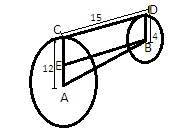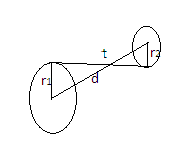
The length of common tangent to the circle of radii $12$cm and $4$cm is $15$ cm. The distance between their centers is $17$cm.
A) True B) False
Answer
492.6k+ views
Hint: We can solve the problem by using pythagoras theorem by making figure on given conditions or we can also solve using the formula ${\text{d = }}\sqrt {{{\text{t}}^2} + {{\left( {{{\text{r}}_1} - {{\text{r}}_2}} \right)}^2}} $ where d is the distance between the centers of two circles with radii ${{\text{r}}_1}$ and ${{\text{r}}_2}$, and t is the length of the common tangent. On putting the given values, you’ll get the answer.
Complete step by step answer:
Given, the length of common tangent to the circles = $15$cm and the radii of the two circles are $12$cm and $4$cm. We have to find the distance between their centers. Let A and B be the centers of the two circles respectively and CD be the common tangent to the circles. Let us draw EB $\parallel $CD to make rectangle BDCE where CD=EB=$15$cm and EC=BD= $4$cm

Now from the figure, AE=AC-CE
$ \Rightarrow {\text{AE = 12 - 4 = 8}}$ cm

Now In the triangle BEA, We know EB and AE but we have to find AB.
Let AB=x cm. Since ∆ BEA is a right-angled triangle, we can use the Pythagoras theorem to find AB. According to the Pythagoras theorem, “In a right-angled triangle, the square of the hypotenuse side is equal to the sum of squares of the other two sides.”It can be written as-
$ \Rightarrow $ \[{{\text{H}}^2} = {{\text{P}}^2}{\text{ + }}{{\text{B}}^2}\]
Where H is the hypotenuse, P is the perpendicular and B is the base of the triangle.
In triangle BEA, H=AB, P=EB and B=AE
Then on using the formula, we get
$ \Rightarrow $ ${\left( {{\text{AE}}} \right)^2} + {\left( {{\text{EB}}} \right)^2} = {\text{A}}{{\text{B}}^2}$
$
\Rightarrow {{\text{x}}^2} = {\left( 8 \right)^2} + {\left( {15} \right)^2} = 64 + 225 = 289 \\
\Rightarrow {\text{x}} = \sqrt {289} = 17 \\
$
AB=$17$ cm= the distance between the centers of the two circles. So the statement is true.
Hence the correct answer is ‘A’.
Note:: We can also use the formula ${\text{d = }}\sqrt {{{\text{t}}^2} + {{\left( {{{\text{r}}_1} - {{\text{r}}_2}} \right)}^2}} $ where d is the distance between the centers of two circles with radii ${{\text{r}}_1}$ and${{\text{r}}_2}$, and t is the length of the common tangent and we’ll get the same answer. This formula is used when the circles have a direct common tangent. On putting the given values we get,
$ \Rightarrow $ d=$\sqrt {{{15}^2} + {{\left( {12 - 4} \right)}^2}} = \sqrt {225 + {8^2}} = \sqrt {225 + 64} $
$ \Rightarrow $ d=$\sqrt {289} = 17$ cm
But If the circles have transverse common tangent (see the figure)-

Then we use formula for distance between their centers ${\text{d = }}\sqrt {{{\text{t}}^2} + {{\left( {{{\text{r}}_1}{\text{ + }}{{\text{r}}_2}} \right)}^2}} $ where the notations have same meaning.
Complete step by step answer:
Given, the length of common tangent to the circles = $15$cm and the radii of the two circles are $12$cm and $4$cm. We have to find the distance between their centers. Let A and B be the centers of the two circles respectively and CD be the common tangent to the circles. Let us draw EB $\parallel $CD to make rectangle BDCE where CD=EB=$15$cm and EC=BD= $4$cm

Now from the figure, AE=AC-CE
$ \Rightarrow {\text{AE = 12 - 4 = 8}}$ cm

Now In the triangle BEA, We know EB and AE but we have to find AB.
Let AB=x cm. Since ∆ BEA is a right-angled triangle, we can use the Pythagoras theorem to find AB. According to the Pythagoras theorem, “In a right-angled triangle, the square of the hypotenuse side is equal to the sum of squares of the other two sides.”It can be written as-
$ \Rightarrow $ \[{{\text{H}}^2} = {{\text{P}}^2}{\text{ + }}{{\text{B}}^2}\]
Where H is the hypotenuse, P is the perpendicular and B is the base of the triangle.
In triangle BEA, H=AB, P=EB and B=AE
Then on using the formula, we get
$ \Rightarrow $ ${\left( {{\text{AE}}} \right)^2} + {\left( {{\text{EB}}} \right)^2} = {\text{A}}{{\text{B}}^2}$
$
\Rightarrow {{\text{x}}^2} = {\left( 8 \right)^2} + {\left( {15} \right)^2} = 64 + 225 = 289 \\
\Rightarrow {\text{x}} = \sqrt {289} = 17 \\
$
AB=$17$ cm= the distance between the centers of the two circles. So the statement is true.
Hence the correct answer is ‘A’.
Note:: We can also use the formula ${\text{d = }}\sqrt {{{\text{t}}^2} + {{\left( {{{\text{r}}_1} - {{\text{r}}_2}} \right)}^2}} $ where d is the distance between the centers of two circles with radii ${{\text{r}}_1}$ and${{\text{r}}_2}$, and t is the length of the common tangent and we’ll get the same answer. This formula is used when the circles have a direct common tangent. On putting the given values we get,
$ \Rightarrow $ d=$\sqrt {{{15}^2} + {{\left( {12 - 4} \right)}^2}} = \sqrt {225 + {8^2}} = \sqrt {225 + 64} $
$ \Rightarrow $ d=$\sqrt {289} = 17$ cm
But If the circles have transverse common tangent (see the figure)-

Then we use formula for distance between their centers ${\text{d = }}\sqrt {{{\text{t}}^2} + {{\left( {{{\text{r}}_1}{\text{ + }}{{\text{r}}_2}} \right)}^2}} $ where the notations have same meaning.
Recently Updated Pages
Master Class 12 Economics: Engaging Questions & Answers for Success

Master Class 12 Maths: Engaging Questions & Answers for Success

Master Class 12 Biology: Engaging Questions & Answers for Success

Master Class 12 Physics: Engaging Questions & Answers for Success

Master Class 12 Business Studies: Engaging Questions & Answers for Success

Master Class 12 English: Engaging Questions & Answers for Success

Trending doubts
Draw a labelled sketch of the human eye class 12 physics CBSE

The final image formed by a compound microscope is class 12 physics CBSE

Differentiate between homogeneous and heterogeneous class 12 chemistry CBSE

What are the major means of transport Explain each class 12 social science CBSE

Which of the following properties of a proton can change class 12 physics CBSE

What is the energy band gap of silicon and germanium class 12 physics CBSE




